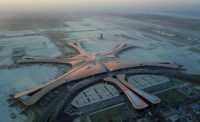Beijing
In the big, big world of Chinese architecture—big projects, big sites, big firms, big country—Vector Architects is keeping it small. In six years, the Beijing-based firm has developed a rich portfolio filled with sales centers, a school, a hotel, a community center, and more, with nary a skyscraper or residential complex in sight. While the scale of the work is certainly affected by the economics of starting a firm, it is also a conscious choice of Vector’s founder, Gong Dong, 42. “We choose projects for which clients are willing to do something special or meaningful, rather than just make money,” he says. By focusing on small and midsize projects that have attentive clients, Dong has been able to create a body of work with more depth than its scale would suggest.Both “Vector” and the firm’s Chinese name (Zhi Xiang, or “strict direction”) suggest Dong’s design intention: to be “straightforward and simple,” he says. Vector’s first project—a green-technology showroom in 2009 for developer China Resources (CR) Land—was a rectangular sales center that fronts a housing complex in Beijing. While China’s residential towers are typically standardized, unadventurous buildings cranked out by large design institutes, the structures built to attract buyers need to have more sizzle. So developers often hire talented young firms and give them a surprising amount of design freedom. For this project, Vector built a long, elevated steel tube punctuated by a painterly composition of windows and covered with a living green roof and walls—a design that is at once simple and complex. Vector has since completed two additional sales centers: a tranquil, inward-looking building that thwarts the surrounding construction in Hefei and a private building with a public observation tower in Liaoning.
Dong is one of many Chinese architects who studied and worked in the U.S. before returning home to establish their own practices. While in the U.S., he spent three years at Steven Holl Architects, working under Holl’s partner Li Hu on the Linked Hybrid complex in Beijing. (Li Hu has since set up his own firm, OPEN Architecture, in Beijing.) Dong says that in the U.S., he learned to eschew idealized concepts and instead start each design from site-specific information such as sunlight, wind forces, and local culture. This interest in phenomenology may partly come from working for Holl, but Dong notes the influence of Henry Plummer, his advisor at the University of Illinois at Urbana-Champaign, who specializes in daylighting. Plummer’s hand can be seen in Vector’s Seashore Library in Nandaihe, which functions almost as a sundial. A broad eastern window and a low slit on the west bring dramatic morning and afternoon light into its main reading room, while a skylight in a windowless meeting room turns midday sun into a work of art in light.
Dong studies ideas such as these through sketches and physical models. To manage his design-intensive work, he keeps his staff of international employees to just 20—small by Chinese standards. He sends an architect to live on-site and manage each project, which is an atypical (and usually unbillable) practice in China. The great amount of effort that Dong puts into the little details is not what comes to mind when one thinks of Chinese architecture. But it is one of the main reasons for Vector’s success.
Vector Architects
FOUNDED: 2008
DESIGN STAFF: 20
PRINCIPALS: Gong Dong
EDUCATION: University of Illinois, Urbana-Champaign, M.Arch. 2001; Tsinghua University, M.Arch. 1999 and B.A. 1994
WORK HISTORY: Steven Holl Architects, 2005-08; Richard Meier & Partners, 2004-05; Soloman Cordwell Buenz & Associates, 2001-04
KEY COMPLETED PROJECTS: Bayuquan Vanke Exhibition Centre, Yingkou, 2013; Zhangjiawo Elementary School, Tianjin, 2010; Momentary City-CR Land Hefei Dongdajie Sales Pavilion, 2009; CR Land Guanganmen Green Technology Showroom, Beijing, 2008
KEY CURRENT PROJECTS: Alila Hotel, Yangshuo, 2015; Seashore Library, Nandaihe, 2015
WEBSITE: www.vectorarchitects.com
People |
Products |


